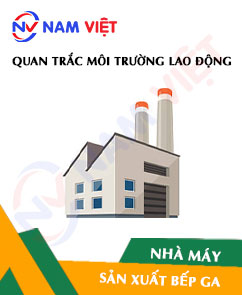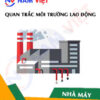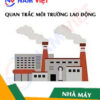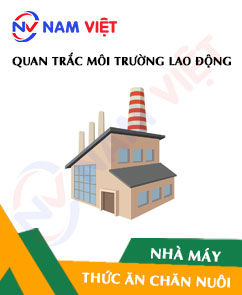Occupational environment monitoring at a gas stove manufacturing factory
99,000 ₫
Note: The above price is calculated for one sample. Prices may vary depending on the area of the environment to be monitored and market fluctuations. For more accurate pricing, please refer to the price list or contact our consulting staff directly.
Monitoring the environment of gas stove production factories involves collecting, analyzing, and evaluating workplace factors that may be harmful to workers health.
Table of Contents
Toggle1. Overview of Gas Stove Manufacturing Factory
a. What is a gas stove manufacturing factory?
Factory producing gas stoves is an industrial facility specialized in manufacturing and assembling kitchen appliances that use gas, such as gas stoves. These factories typically have modern production lines and standard manufacturing processes to produce gas stoves with various technologies and features.
In a gas stove manufacturing factory, the production processes include processing parts, assembly, quality control, and packaging of products. Gas stove components include the main burner, auxiliary burner, control unit, gas valve, gas cylinder, and other accessories. The factory has machinery, production lines, and professional technicians to carry out the manufacturing steps and ensure the quality of the final product.
Gas stove factories often offer a wide range of product lines and designs to meet market demands and consumer preferences. The final products are distributed and displayed in retail stores, supermarkets, or online platforms for consumers to purchase and use at home or in other kitchen spaces.

b. Production stages in a gas stove manufacturing factory
The production stages in a gas stove factory include the following processes:
- Product design and development: Gas stove factories typically have a team of professional engineers and designers to develop and design new models and features. This process includes market research, technical design, and creation of technical drawings and prototypes.
- Parts processing: Gas stove components such as the outer casing, main burner, auxiliary burner, gas valves, gas cylinders, and other accessories are processed from materials like steel, aluminum, and other heat-resistant materials. Processing steps may include cutting, bending, punching, welding, grinding, and surface finishing.
- Assembly: Processed parts are assembled into complete gas stove products. The assembly stage includes joining and fixing components, installing gas connections, valves, indicator lights, control knobs, and other stove details.
- Quality inspection: After assembly, gas stoves undergo quality checks to ensure they operate correctly and meet quality standards. Inspection may include functional testing, gas pressure testing, safety checks, and aesthetic evaluation.
- Packaging: After quality checks, gas stoves are packaged to protect them during transport. Packaging includes placing products into cartons, using foam or other protective materials, including user manuals and warranty documents, and attaching product labels.
- Transportation and distribution: Packaged products are transported from the factory to sales points or distributors for delivery to consumers.

c. Types of machinery used in a gas stove manufacturing factory
In a gas stove manufacturing factory, various types of machinery are used for production and processing. Common machines include:
- Metal cutting and bending machines: Used to cut and bend metal sheets such as steel and aluminum to create stove components like outer casings, main burners, and auxiliary burners. Machines may include plasma cutters, laser cutters, or tube bending machines.
- Welding machines: Used to weld metal components together to form a complete gas stove. Various types of welding machines are used, such as MIG/MAG, TIG, or spot welding machines.
- Surface processing machines: Used to finish metal surfaces for smoothness and aesthetics. Machines include grinders, polishers, or electrostatic painting equipment.
- Plastic and rubber pressing/cutting machines: Used to press and cut plastic or rubber parts for accessories and smaller components.
- Gas tube pressing and welding machines: Used to press and weld gas tubes and valves to create the stove’s gas supply system.
- Woodworking machines: For stoves with wooden components, machines such as wood cutters, polishers, and sanders may be used.

d. Occupational diseases that gas stove factory workers may face
Workers in gas stove factories may be exposed to harmful factors that can cause occupational diseases. Common occupational diseases include:
- Respiratory diseases: Exposure to gas fumes, welding fumes, chemical additives, or metal dust may irritate or inflame the respiratory tract, causing rhinitis, pharyngitis, bronchitis, and pneumonia, which can lead to breathing difficulties, coughing, or other respiratory issues.
- Skin diseases: Exposure to chemicals such as solvents, detergents, or additives may cause skin irritation, infections, eczema, or dermatitis. Dry, dusty environments or contact with hard materials may also cause cuts and abrasions.
- Ear, nose, and throat diseases: Exposure to loud noise from metal processing or industrial machinery may damage hearing and cause issues such as hearing loss, tinnitus, and sinus inflammation.
- Musculoskeletal disorders: Tasks involving lifting, pulling, twisting, or working in uncomfortable positions may cause muscle strain, joint inflammation, back pain, and spinal problems.
- Stress-related disorders: High-pressure work environments, tight deadlines, and increased workload can cause stress, negatively affecting workers’ mental and psychological health.

e. Common types of gas stoves in the market
There are various types of gas stoves on the market, depending on design, function, and technology. Common types include:
- Tabletop gas stoves: Compact and portable, usually placed on a table or countertop. They typically have 1 to 4 burners and are suitable for small apartments, guesthouses, or outdoor activities.
- Built-in gas stoves: Installed into the countertop or kitchen surface. Integrated into the kitchen design for a smooth, easy-to-clean surface. Available in different sizes and styles to suit space and usage needs.
- Freestanding gas stoves: Larger units, usually installed separately. May include single or double burners and features such as grilling, warming, and exhaust fans. Suitable for users with high cooking demands and larger kitchen spaces.
2. Overview of Workplace Environmental Monitoring Services
a. What is workplace environmental monitoring in gas stove factories?
Workplace environmental monitoring (or occupational environment measurement) in gas stove factories is the activity of collecting, evaluating, and analyzing measurement indicators of workplace environmental factors in the factory. This aims to implement timely measures to reduce environmental harm to workers’ health and prevent occupational diseases. Environmental monitoring is mandatory for gas stove factories.
Workplace environmental monitoring plays a critical role in protecting and enhancing worker health because employees are the main resource and directly generate profit for the enterprise. Workers frequently exposed to occupational hazards above permitted limits may suffer health effects and develop occupational diseases.
REGISTER FOR WORKPLACE ENVIRONMENT MONITORING SERVICE
b. Nam Viet’s workplace environmental monitoring program
Nam Viet’s workplace environmental monitoring program is developed by environmental monitoring engineers specializing in occupational safety and environmental protection. Aiming to ensure health and safety for workers, the program uses modern measurement methods to monitor air quality, water, microclimate, physical factors, dust, and more in the workplace. This program is essential for maintaining a safe working environment and protecting workers’ health.
Additionally, Nam Viet’s program plays a crucial role in researching and developing new solutions to improve workplace environmental quality. With the dedication and professionalism of its experts, Nam Viet’s exclusive monitoring program has become a breakthrough in occupational safety and environmental management in Vietnam.

c. Standardization in workplace measurement procedures
Standardization in Nam Viet’s workplace measurement procedures is vital for ensuring accurate and reliable results. To guarantee precision, the program uses recognized standards and procedures from the Ho Chi Minh City Department of Health. This ensures collected data is highly reliable for evaluating workplace conditions and making decisions to improve the work environment and protect workers’ health.
These standardized procedures also ensure that measurements are conducted by highly qualified monitoring specialists with years of experience, allowing managers and experts to trust An Toan Nam Viet’s results and make accurate, valuable decisions for protecting employee health and the environment.
By applying standardized workplace measurement procedures, Nam Viet demonstrates its commitment to providing a safe working environment and protecting workers’ health, while contributing positively to improving occupational safety and environmental management in Vietnam.
d. Workplace environmental monitoring reports for gas stove factories
Workplace environmental monitoring results are prepared according to Form 04, Appendix III issued with Decree 44/2016/ND-CP and made in 2 copies: 1 copy is sent to the enterprise that contracted the monitoring service, and 1 copy is kept by the monitoring organization.
The retention period for monitoring results is indefinite, in accordance with the law.

e. Frequency of workplace environmental monitoring according to law
According to Clause 2 of Article 18 of Law on Occupational Safety and Hygiene 84/2015/QH13, employers must organize workplace environmental monitoring to evaluate harmful factors at least once a year.
f. Deadline for submitting workplace environmental monitoring reports according to law
The submission deadline is before December 31 each year. Enterprises at production facilities must submit workplace environmental monitoring reports to the local Department of Health at the location of the production facility’s headquarters and the workplaces of employees.
Whenever there are changes in production technology, processes, or when upgrading the facility with potential new hazards to workers’ health, enterprises must update their occupational hygiene records regarding harmful factors requiring environmental monitoring.
g. Penalties for violations of workplace environmental monitoring for employers
According to Article 27 of Decree No. 12/2022/ND-CP dated January 17, 2022, on administrative penalties in the fields of labor, social insurance, and Vietnamese workers working abroad under contracts:
- Clause 2: Fines from 2,000,000 – 5,000,000 VND for employers who fail to publicly inform employees at the monitoring site and where hazards are evaluated immediately after receiving environmental monitoring and hazard assessment results.
- Clause 3: Fines from 20,000,000 – 40,000,000 VND for employers who fail to conduct workplace environmental monitoring to control health hazards according to the law.
- Clause 4: Fines from 40,000,000 – 60,000,000 VND for employers who collude with monitoring organizations to commit fraud in environmental monitoring activities without reaching criminal liability.
3. Harmful Environmental Factors for Workers in Gas Stove Manufacturing Factories
Workers in gas stove manufacturing factories may be exposed to several harmful environmental factors. The following are common factors that could affect workers’ health:
- Gas: The use and handling of gas during stove production can be dangerous. Gases such as propane or butane can cause poisoning or explosions if not used or stored properly.
- Fumes from welding and metals: Welding and metalworking processes can produce welding fumes and metal vapors, including heavy metals (such as lead) and metal compounds that may be harmful if inhaled. Long-term exposure to these compounds can lead to health issues, including lead toxicity and respiratory diseases.
- Dust and grinding particles: Using metalworking and surface finishing machines can generate dust and grinding particles. Inhalation of these particles can cause irritation or pneumonia and may contain carcinogenic substances such as heavy metals and chemical compounds.
- Chemicals: Gas stove production may involve additives, cleaning agents, and paints, which pose risks of exposure to chemicals that can irritate the skin, eyes, and respiratory system.
- Noise: Machinery and production processes in gas stove factories can generate high noise levels. Continuous and loud noise can cause stress, insomnia, and long-term damage to workers’ hearing.
- Temperature and pressure: During gas stove production, workers may work in high-temperature or high-pressure environments, causing discomfort and health risks.
REGISTER FOR OCCUPATIONAL ENVIRONMENT MONITORING SERVICE
4. Measures to Improve the Working Environment in Gas Stove Factories
To improve the working environment in gas stove factories and ensure workers’ health, the following measures can be applied:
- Ensure ventilation and exhaust systems: Install effective ventilation systems to remove gas and welding fumes from the workspace. Provide strong exhaust fans to remove dust, welding fumes, and chemicals from the production process.
- Use protective equipment: Ensure that workers are properly equipped with and correctly use personal protective equipment, including safety goggles, masks, gloves, and protective clothing, to prevent direct exposure to chemicals, dust, and noise.
- Training and guidance: Provide thorough training and guidance for workers on occupational safety, safe work procedures, and the use of protective equipment. Ensure they understand potential hazards and know how to prevent occupational diseases.
- Regular inspection and maintenance of equipment: Conduct periodic inspections and maintenance of machinery, equipment, and safety systems to ensure proper functioning and reduce the risk of accidents.
- Noise reduction: Implement measures to reduce factory noise, including soundproofing and providing ear protection for workers.
- Waste management: Ensure proper disposal of waste generated during gas stove production in compliance with relevant environmental regulations. This includes proper classification, recycling, or safe handling of chemical and solid waste.
- Regularly conduct occupational environment monitoring in factories to collect and analyze harmful factors for workers, then adjust to reduce risks to prevent occupational diseases.
5. Benefits of Periodic Gas Stove Factory Environment Monitoring
An Toan Nam Viet provides businesses with excellent benefits when using occupational environment monitoring services according to Decree 44/2016/NĐ – CP on managing and controlling harmful factors in the workplace affecting workers.
- Businesses can proactively control harmful factors in workshops or factories.
- Receive advice and recommendations to reduce harmful factors and improve workplace environmental quality.
- Indirectly protect human resources, a key factor in business development.
- Reduce the impact of occupational diseases on health, minimizing future medical costs.
- Improved worker health leads to higher product quality and ensures consistent production output.
- Ensure compliance with labor safety regulations and avoid legal risks.
- Enhance credibility and professionalism, elevating the company’s brand.
An Toan Nam Viet’s environmental monitoring service is a solution to reduce occupational disease risks, contributing to a clean and high-quality working environment.

6. Nationwide Occupational Environment Monitoring Center
An Toan Nam Viet Occupational Environment Monitoring Center is a professional unit for supervising and measuring occupational environment quality across all provinces in Vietnam. With experienced monitoring specialists, the center uses modern measuring equipment to ensure accuracy and reliability.
In addition to monitoring services, the center assists clients in planning, managing, and tracking workplace environmental issues. With the motto “customer-centric,” the center prioritizes client satisfaction and provides optimal solutions for businesses.
REGISTER FOR OCCUPATIONAL ENVIRONMENT MONITORING SERVICE
With investments in technology, equipment, and workforce, An Toan Nam Viet’s monitoring center has become a reputable unit in occupational environment monitoring in Ho Chi Minh City with the following objectives:
- We value our brand reputation and the quality of our services.
- We provide clients with the best and most suitable solutions.
- Alongside experienced Masters and Engineers, aiming to protect the environment and benefit businesses.
- Clients using An Toan Nam Viet monitoring services receive professional support from experts and the best cost advantages.
The occupational environment monitoring process at An Toan Nam Viet includes the following steps:
- Before monitoring, ensure all equipment is calibrated according to legal regulations.
- Follow the committed occupational environment monitoring procedures with the Department of Health.
- Report monitoring results honestly to employers.
- If results indicate unsafe conditions, An Toan Nam Viet will support remediation measures, and the workplace will:
- Implement measures to improve working conditions, minimizing harmful factor exposure and preventing occupational diseases.
- Organize health check-ups to detect occupational diseases early for workers in unsafe positions.
- Provide material compensation to workers according to labor law regulations.

7. Occupational Environment Monitoring Pricing
To help businesses conduct professional and effective occupational environment monitoring, An Toan Nam Viet provides a detailed price list for monitoring services with quality and reasonable costs.
- Our price list provides detailed information on all monitoring services offered, including costs for travel, measurement, analysis, and reporting. Clients can trust the accuracy and reliability of our monitoring reports.
- We commit to offering competitive and reasonable prices, while providing fast and professional consultation for all monitoring service inquiries.
- With An Toan Nam Viet’s monitoring price list, clients can easily select service packages suitable for their needs, ensuring maximum satisfaction with professional service quality.
No comments yet












Review Occupational environment monitoring at a gas stove manufacturing factory
There are no reviews yet.